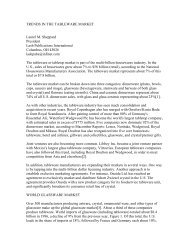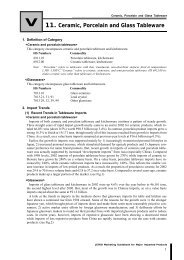eu market survey 2003 - crecer
eu market survey 2003 - crecer
eu market survey 2003 - crecer
Create successful ePaper yourself
Turn your PDF publications into a flip-book with our unique Google optimized e-Paper software.
Origin of imports<br />
Although EU manufacturers still dominate the <strong>market</strong>, their position is steadily declining. In<br />
1997, the EU manufacturers accounted for 70 percent of the EU import and, five-years later, this<br />
share had dropped to 65 percent. Despite the fierce competition, mainly from China, which is the<br />
largest EU supplier of plasticware (15% of the total EU import in value), the EU manufacturers<br />
still play a dominant role in the EU <strong>market</strong>. The dominance of the EU manufacturers is mainly<br />
due to the “economies of scale”, which enable the manufacturers to produce at low cost. (See also<br />
chapter 4). In 2001, 65 percent of the total import derived from EU-countries. The most import<br />
suppliers in the EU are Spain (14% of the total EU import in value), Italy (10%), Germany (10%),<br />
France (9%) and the Netherlands (7%). Other important non-EU suppliers are the United States<br />
(4%), Taiwan (3%) and Poland (3%).<br />
Glassware<br />
In 2001, the EU import of glassware dropped by 2 percent in value terms, to a value of € 1.85<br />
billion. The imported volume amounted to 780,000 tons, representing a drop of 9 percent in<br />
comparison with 2000. Over the period between 1997 and 2001, the glassware <strong>market</strong> shows a<br />
growth trend, as volume increased by 18 percent.<br />
Looking at a national level, we see that only a few countries show growth in 2001. Germany and<br />
France together with the United Kingdom are the leading import <strong>market</strong>s, with shares of<br />
respectively 20, 12 and 15 percent. The UK, together with Ireland, ranks amongst the highest<br />
growth <strong>market</strong>s in the EU that year. The United Kingdom, however, shows an interesting<br />
development, as the imported value increased by 7 percent, whereas the volume dropped by<br />
almost 14 percent. The Belgium/ Luxembourg import also shows in interesting development, in<br />
2000, as the import increased by 34 percent, whereas in 2001, the import dropped by 28 percent.<br />
Over a longer period of time, the Netherlands shows the highest growth, but this growth occurred<br />
mainly in the late nineties. In 2000, the Dutch import even dropped by 13 percent on a volume<br />
basis, whereas, the value grew by 10 percent. In 2001, however the imported volume increased by<br />
a mere 3 percent. France and Spain also showed a growth in terms of volume, both import<br />
<strong>market</strong>s grew by 5 percent. The import of Germany and Italy declined by 5 and 3 percent that<br />
same year.<br />
Figure 5.11 Relative attractiveness of EU-countries with respect to the import development of<br />
glassware<br />
15%<br />
% growth 2001 in €<br />
Ireland<br />
10%<br />
United Kingdom<br />
Greece<br />
5%<br />
Finland<br />
Denmark<br />
France<br />
Austria<br />
Spain 0%<br />
Sweden<br />
Netherlands<br />
-15% -5% 5% 15% 25% 35% 45% 55%<br />
-5%<br />
Italy<br />
-10%<br />
Portugal Germany<br />
-15%<br />
Belgium/ Luxembourg<br />
-20%<br />
-25%<br />
% growth 1997 - 2001 in volume<br />
Source: Eurostat, 2002<br />
42





